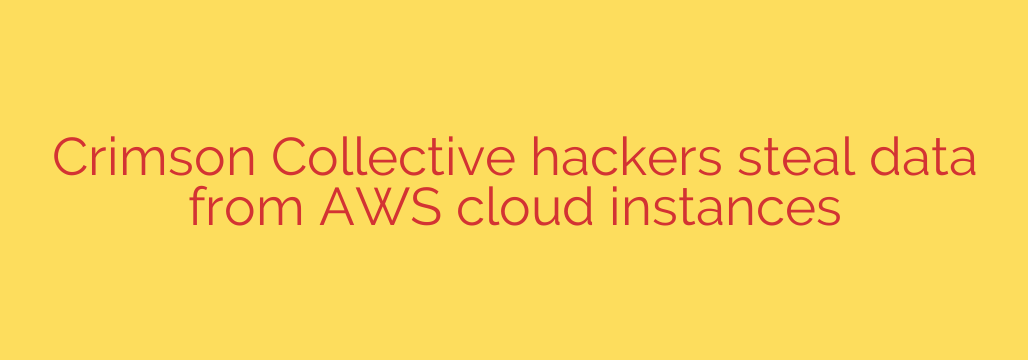
New Threat Actor ‘Crimson Collective’ Actively Targeting Insecure AWS Cloud Instances
The landscape of cybersecurity is constantly evolving, and a new threat actor, dubbed the “Crimson Collective,” has emerged with a clear focus: exploiting misconfigured and poorly secured Amazon Web Services (AWS) cloud environments. This group has been linked to a series of recent data breaches, successfully exfiltrating sensitive corporate data and highlighting the critical importance of robust cloud security practices.
Understanding how this group operates is the first step toward building an effective defense. Their tactics, while sophisticated, often rely on exploiting common security oversights that can be easily remediated. By taking a proactive approach, organizations can significantly reduce their risk of becoming the next victim.
How Crimson Collective Breaches Cloud Defenses
Analysis of recent incidents reveals that the Crimson Collective is not using zero-day exploits but is instead capitalizing on fundamental security gaps. Their primary methods of gaining initial access are consistent and preventable.
- Exposed API Keys and Credentials: A leading cause of breaches involves developers accidentally leaking AWS access keys. Hackers systematically scan public code repositories like GitHub, pastebins, and even client-side mobile application code for hardcoded credentials. Once found, these keys provide a direct pathway into an organization’s cloud infrastructure.
- Publicly Accessible S3 Buckets: Misconfigured Amazon S3 buckets remain a major vulnerability. The Crimson Collective actively scans for buckets that are left open to the public, allowing them to access and download entire datasets containing customer information, internal documents, and proprietary data without needing to bypass any authentication.
- Weak Identity and Access Management (IAM) Policies: A failure to adhere to the principle of least privilege is another common entry point. Overly permissive IAM roles can grant a compromised user or service far more access than necessary. If an attacker gains control of such an account, they can move laterally across the AWS environment, accessing databases, storage, and other critical services.
Once inside, the group’s objective is clear: locate and exfiltrate the most valuable data as quickly as possible. This stolen information is then often held for ransom or sold on dark web forums, posing a severe financial and reputational risk to the compromised organization.
Actionable Steps to Secure Your AWS Environment Now
Protecting your organization from groups like the Crimson Collective doesn’t require reinventing your security strategy. It requires a diligent focus on foundational cloud security principles. Here are essential steps every organization using AWS should implement immediately.
Enforce the Principle of Least Privilege: Never use the root AWS account for daily tasks. Instead, create IAM roles with the minimum permissions necessary for a user or application to perform its function. Regularly audit your IAM policies to remove excessive permissions and ensure roles are tightly controlled.
Scan for and Eliminate Exposed Secrets: Implement automated tools in your CI/CD pipeline to scan for hardcoded secrets before code is ever pushed to a public repository. Educate your development teams on the critical danger of embedding credentials in code and enforce the use of secure secret management tools like AWS Secrets Manager or HashiCorp Vault.
Lock Down Your S3 Buckets: Treat all data as sensitive. Enable “Block Public Access” settings at the account level for all S3 buckets by default. Access should only be granted through specific IAM policies or S3 Access Points. Never assume a bucket is private; always verify its configuration.
Leverage AWS Security Services: Amazon provides a powerful suite of tools designed to protect your environment.
- AWS GuardDuty: This is a threat detection service that continuously monitors for malicious activity and unauthorized behavior. Enable it in all regions.
- Amazon Macie: Use Macie to discover and protect your sensitive data in S3. It uses machine learning to automatically identify personally identifiable information (PII) and other valuable data.
- AWS Security Hub: This tool gives you a comprehensive view of your high-priority security alerts and compliance status across your AWS accounts.
Implement Multi-Factor Authentication (MFA): Enforce MFA for all users, especially for privileged IAM accounts and the root user. This simple step adds a crucial layer of security that can prevent an attacker from using stolen credentials to access your environment.
The rise of specialized threat actors like the Crimson Collective serves as a stark reminder that cloud security is a shared responsibility. While AWS secures the underlying infrastructure, your organization is responsible for securing what you build in the cloud. By adopting a security-first mindset and diligently applying these best practices, you can fortify your defenses and protect your critical data from this growing threat.
Source: https://www.bleepingcomputer.com/news/security/crimson-collective-hackers-target-aws-cloud-instances-for-data-theft/








